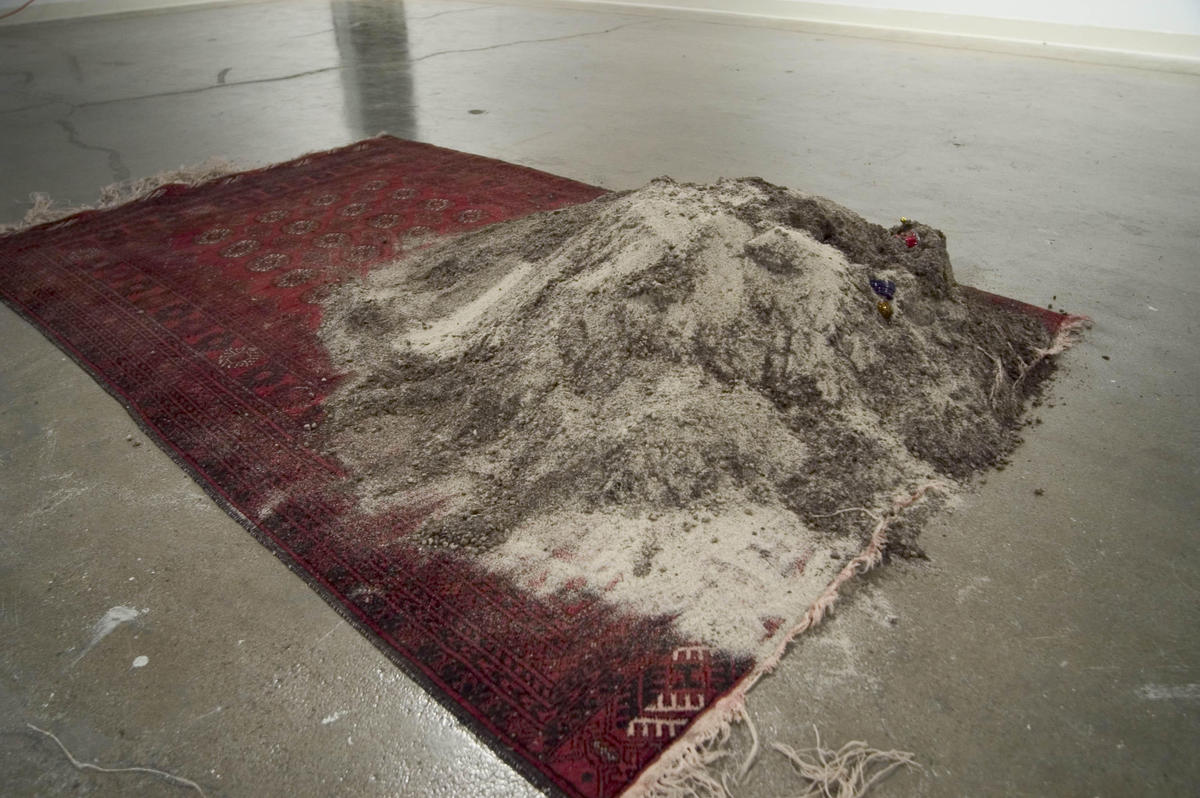
Orange
Poetics of Proximity
Chapman University
February 7–March 20, 2004
“Poetics of Proximity” opened on February 7, 2004, at the Guggenheim Gallery, Chapman University, and ran until March 20. Featuring the work of transnational artists from Afghanistan, Algeria, Iran, Morocco, and Turkey, this critical exhibition was the first in Southern California to feature artists from these countries and address the complexities of living as Arabs and Muslims in the West.
Curators Lida Abdul and Gul Cagin — two installation artists whose work also appeared in the show — had envisioned an exhibition that would complicate stereotypical readings of “Islam” and “Islamic Art”; the diverse range of Central and Southwest Asian/North African work was presented within the broad scope of culture and representation and politics, unrestricted by any one category, ideology or aesthetic.
Poetics of Proximity sought to re-establish borders and homelands, and create alternative realities of worldwide struggles against colonization. The artists — Moroccan, Turkish, Iranian, Afghan and Algerian — eroded fixed boundaries of nationality, re-imagining their various national and cultural identities from the fractured spaces of “citizen,” “immigrant,” “foreign national,” and “expatriate.” The homogenization of the Middle East — especially in relation to the post-9/11 politics of preemption, the protracted war on Iraq, and the Bush Administration’s policy of unilateralism — has created the specter of the alien-subject, who exists elusively but nonetheless, definitively, in the US nation-state’s collective imagination.
Artists Lida Abdul, Gul Cagin, Abdelali Dahrouch, Taraneh Hemami, Masood Kamady, Habib Kheradyar, Arzu Kosar, Serkan Okaya, and Zineb Sedira addressed how politics of distance have been enforced by exile and imperialism; these historical forces have created new spaces of resistance and new communities that endeavor for social justice and progressive change. The artists’ works converged in meaningful ways even though their themes, visions and media were distinct.
Habib Kheradyar’s performance White on White, Even, consisted of two nylon white cloth panels, between which the artist was confined by an assistant in a silhouette of staples, which contoured his body, and suspended him for an hour and a half. Appropriating Russian Constructivist painter Malevich’s White on White (1918), Kheradyar physically interjected himself between the white frames thus, one could say, creating a third space of belonging, and forcing whiteness to contend with transnational difference.
Abdelali Dahrouch also explored the impact of hegemonic historical narratives in Yellow Citizen. This compelling video installation features a montage of scenes of Japanese Americans being carted to internment camps during WWII, combined with images of Arab Americans post 9/11. Dahrouch painted a yellow band onto the wall across which the video is projected; this band of color swept across the faces of those in the video, and reflected a 7’ by 11’ rectangular floor piece of powdered yellow tempera paint. Yellow Citizen appeared to link the current Bush administration to a legacy of imperialism while at the same time fostering vital ties between disenfranchised communities of color.

Lida Abdul’s Tales from Bacteria featured a prayer rug soiled by a pile of ash, within which a child’s toy is buried, with red lights flashing, “fire, fire.” In a play on words, the title recalls the ancient name of Afghanistan, Bactar, and refers to the West’s erosion of Afghanistan’s cultural heritage. Wrought by imperial invasion and domination, Bactar has evolved into the post-9/11 imaginary of a diseased nation in need of salvation through obliteration.
Zineb Sedira’s Mother Tongue is made up of three 20" television sets, featuring conversations between the artist and her mother, the artist and her daughter, and the daughter and her grandmother. With dialogue in Arabic, French, and English, we find that these women are unable to communicate in a single language. Sedira’s triptych created a moving portrayal of cultural displacement, and the ambivalence engendered by these women’s proximity to and alienation from one another.
Taraneh Hemami’s Hall of Reflections: Remembrances of Iranian Immigrants depicted a collection of her family photographs on mirrored surfaces that occupied a corner of the gallery space from floor to ceiling. I found myself drawn in; the images coax one to negotiate multiple representations of the “Iranian” in relation to the overwrought history of stereotypical images of Muslims in the U.S. Gul Cagin’s installation, Landscape Mimicry, featured alien-like bodies: a three-dimensional seven-foot stuffed animal covered in tin foil; a graphite drawing of a similar form on paper; a single channel video screen; and the physical body of a female dancer. Together these elements came to represent alternative space, and the potential to consider community affiliation across difference. Cagin’s assemblage of esoteric forms visualized a notion of plurality that neither demonizes nor dehumanizes, but rather offers a range of realities, and their proximity to one another.
It is interesting to consider the greater consequences of how Arab/Middle Eastern/Islamic contemporary art is conceived at this particular moment in time, given these provocative works and the curious reception this critical exhibit received. According to co-curator Lida Abdul, the exhibition only received two reviews (including this is one). Both were in magazines based abroad. To the artists, this could suggest a kind of indifference or apathy towards cultural forums that challenge monolithic representations of “Islam.” At a panel discussion, one audience member commented on how surprised she was to see that the works featured could be displayed in any contemporary art forum, rather than being the ornate or exoticized images so often associated with Islamic art. Her comments resonated heavily for the artists who were quick to assert that there is no single, reductive prescription for “Islamic art.” Certainly, Cagin and Abdul’s objective in conceptualizing “Poetics of Proximity” was to precisely undermine such simplistic and erroneous perceptions, but their vision does much more. The exhibition moved beyond narrow representations of “Other” to address cultural specificity in a way that garners a consciousness of diversity and social transformation. As Abdul eloquently said, “‘Poetics of Proximity’ brings about a more reciprocal dialogue not so much between some monolithic ‘East’ and multifaceted ‘West,’ but between different styles of thinking and seeing the world.”
www.poeticsofproximity.com